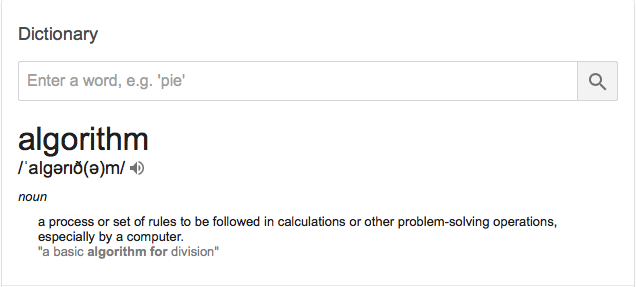We talk a lot about algorithms on this blog, and what SEO strategies we can use to help our clients’ websites to rank better. However, although you need to know what procedures your SEO company are using, it is also worth knowing exactly how the algorithm works in the first place. This will not only help you to understand why we are using the strategies we are but also what we are trying to accomplish and how.
What is an algorithm?
If you search the term ‘algorithm’ and ask Google to define it, the answer you will get is: “A process or set of rules to be followed in calculations or other problem-solving operations, especially by a computer.”
It is not entirely clear really, but what it does tell us is that contrary to popular belief, an algorithm is not a formula. In fact, the easiest way to really understand what an algorithm is, is to think of it as a recipe.
If we think about a good old-fashioned Sunday roast, for example, the meat portion of this recipe needs to be seasoned well and cooked for just the right amount of time. Seasoning the meat is one formula, calculating the temperature and length of time the meat needs to be cooked for is another formula, and so on. Gathering the formulas together for all of the items on our plate would give us an algorithm for creating the end meal. We might then decide to add another formula which would take into account the number of different foods I want on my plate, and then perhaps add a formula for each person who is joining us at the table as they will all want different things.
But what do these formulas and algorithms have to do with search engines?
If we take a look at a few of the core characteristics of a website, such as content, images, page speed, links and URLs, then each of these areas can be divided again using formulas or sub-algorithms. And this is another crucial point to grasp – although there is one over-riding algorithm, there are also many other formulas and algorithms covered by this. The chief algorithm’s job is, therefore, to determine how much weight it puts on each of the other formulas and algorithms to produce the final results we see on the Search Engine Results Pages.
What this means is that when we are talking about algorithms which impact search results, we are generally talking about the under algorithms and not the main one. So, when we refer to Google’s algorithm, we are actually referring to a large number of formulas and algorithms it uses to determine rankings. These include:
- The ‘Panda’ algorithm, released in February 2011, which was aimed at tackling content and probably included a lot of other algorithms within it
- The ‘Penguin’ algorithm, released on April 2012, which was aimed at addressing spam, which probably relies on data from other algorithms which look at the value of links and try to understand common link spam characteristics as well
- Task-specific algorithms, such as Document Relevance Ranking
- Algorithms that organise information, such as keyword matching
The uses of entities
So, now you have a better understanding of how algorithms work, now we need to think about entities. Google has started to focus quite heavily on objects, which it defines as: “A thing or concept that is singular, unique, well-defined and distinguishable.’
In the past, Google has focused on assessing websites and pages as a collection of words, whereas this new focus means they can now more easily classify how websites interconnect and classify them as a whole.
This is important because, in the past, Google judged the relevance of a page to a search query by using word proximity, word density and other such elements which can easily be misinterpreted. However, with entities, either the page is about an entity, or it isn’t – entities are far less open to interpretation.
So, back to the original question:
How do search algorithms work?
- Context is important. When you hear about algorithm updates in the future, you should now understand that the thing that is being updated is just a small piece of the enormous puzzle. Most algorithm updates are adjustments to certain aspects of websites and will fit into the main objective of the search engine in some way.
- Entities are also essential and becoming increasingly so. Understanding this should help you to write better content and work out which links to use as well.
- Last but not least, User Intent is also crucial. At the end of the day, all of the changes to the algorithms that search engines make are concerned with producing the best search results for searchers.
If all this is a little confusing then don’t worry, we can help. As an award-winning search engine optimisation agency based in Alderley Edge, we keep on top of every little tweak to the algorithms on our clients’ behalf. Get in touch today to find out how we can do the same for you.
Search Engine Algorithms: Your Questions Answered!
Digital SEO / Jul 22, 2019
We talk a lot about algorithms on this blog, and what SEO strategies we can use to help our clients’ websites to rank better. However, although you need to know what procedures your SEO company are using, it is also worth knowing exactly how the algorithm works in the first place. This will not only help you to understand why we are using the strategies we are but also what we are trying to accomplish and how.
What is an algorithm?
If you search the term ‘algorithm’ and ask Google to define it, the answer you will get is: “A process or set of rules to be followed in calculations or other problem-solving operations, especially by a computer.”
It is not entirely clear really, but what it does tell us is that contrary to popular belief, an algorithm is not a formula. In fact, the easiest way to really understand what an algorithm is, is to think of it as a recipe.
If we think about a good old-fashioned Sunday roast, for example, the meat portion of this recipe needs to be seasoned well and cooked for just the right amount of time. Seasoning the meat is one formula, calculating the temperature and length of time the meat needs to be cooked for is another formula, and so on. Gathering the formulas together for all of the items on our plate would give us an algorithm for creating the end meal. We might then decide to add another formula which would take into account the number of different foods I want on my plate, and then perhaps add a formula for each person who is joining us at the table as they will all want different things.
But what do these formulas and algorithms have to do with search engines?
If we take a look at a few of the core characteristics of a website, such as content, images, page speed, links and URLs, then each of these areas can be divided again using formulas or sub-algorithms. And this is another crucial point to grasp – although there is one over-riding algorithm, there are also many other formulas and algorithms covered by this. The chief algorithm’s job is, therefore, to determine how much weight it puts on each of the other formulas and algorithms to produce the final results we see on the Search Engine Results Pages.
What this means is that when we are talking about algorithms which impact search results, we are generally talking about the under algorithms and not the main one. So, when we refer to Google’s algorithm, we are actually referring to a large number of formulas and algorithms it uses to determine rankings. These include:
- The ‘Panda’ algorithm, released in February 2011, which was aimed at tackling content and probably included a lot of other algorithms within it
- The ‘Penguin’ algorithm, released on April 2012, which was aimed at addressing spam, which probably relies on data from other algorithms which look at the value of links and try to understand common link spam characteristics as well
- Task-specific algorithms, such as Document Relevance Ranking
- Algorithms that organise information, such as keyword matching
The uses of entities
So, now you have a better understanding of how algorithms work, now we need to think about entities. Google has started to focus quite heavily on objects, which it defines as: “A thing or concept that is singular, unique, well-defined and distinguishable.’
In the past, Google has focused on assessing websites and pages as a collection of words, whereas this new focus means they can now more easily classify how websites interconnect and classify them as a whole.
This is important because, in the past, Google judged the relevance of a page to a search query by using word proximity, word density and other such elements which can easily be misinterpreted. However, with entities, either the page is about an entity, or it isn’t – entities are far less open to interpretation.
So, back to the original question:
How do search algorithms work?
- Context is important. When you hear about algorithm updates in the future, you should now understand that the thing that is being updated is just a small piece of the enormous puzzle. Most algorithm updates are adjustments to certain aspects of websites and will fit into the main objective of the search engine in some way.
- Entities are also essential and becoming increasingly so. Understanding this should help you to write better content and work out which links to use as well.
- Last but not least, User Intent is also crucial. At the end of the day, all of the changes to the algorithms that search engines make are concerned with producing the best search results for searchers.
If all this is a little confusing then don’t worry, we can help. As an award-winning search engine optimisation agency based in Alderley Edge, we keep on top of every little tweak to the algorithms on our clients’ behalf. Get in touch today to find out how we can do the same for you.
Array

